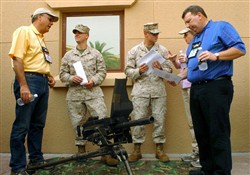
John Hagistad (left) and Peter Sudler, members of Joint Civilian Orientation Conference 73, talk with members of the Marine security team assigned to protect the assets and personnel assigned to U.S. Naval central Command Headquarters in Bahrain, April 26, 2007. U.S Air Force photo by Tech. Sgt. Jeffrey Allen
|
|
MANAMA, Bahrain, April 27, 2007 – Marines from the 3rd Fleet Anti-terrorism Security Team put on an impressive display here yesterday for visiting members of the Defense Department’s Joint Civilian Orientation Conference.
The 45 business and civic leaders who are participating in a whirlwind tour of military installations in the U.S. Central Command area of responsibility had the opportunity to interact with Marines, check out their equipment and watch a martial arts demonstration from the Marines deployed here.
Following a briefing from Marine Col. William Hardy, U.S. Marine Forces Central Command, on the involvement of Marine coordination elements and the success of Marines within Iraq and Afghanistan, the participants got a chance to see vehicles, body armor, communications equipment and weapons used by the 3rd FAST during their six-month deployment to the region.
The unit serves as a quick-reaction force in the area to provide security for embassies and other anti-terrorism operations. They will be leaving in two days to return home to Camp Allen, Va., after what they are calling “a quiet deployment” where they saw little action.
“Our mission here was extremely important,” said Marine Cpl. James Tucker. “I may be a little biased, but I think that Marines are the most professional fighting force in the world.”
There is no better force to have on quick-reaction status, he said. “We served an important role for the governments in this area by being on standby 24 hours a day.”
Marine Staff Sgt. Charles Burnett echoed the same pride in his Corps when orchestrating a demonstration of the Marine Corps martial arts program with troops in his unit.
Burnett said the training, which became a mandatory part of Marine boot camp in 1999, is based on a show of continual force.
“You have to make quick judgments and ensure that you get control of combat situations as soon as possible,” he explained to the audience.
Participants were impressed as the Marines threw their fellow team members to the ground and responded to mock attacks with a number of holds and offensive and defensive moves.
Just like other martial arts, the Marine Corps martial artists build on discipline and character by discussing warrior case studies during their training, Burnett said. “We talk about past Marines who have been honored for their extraordinary efforts and who have set an example for the rest of us to follow.”
“It preaches a warrior ethos that inspires a culture,” said Marine Capt. Ed Hinman, platoon commander for the 3rd FAST.
The intangibles they give Marines – assertiveness, confidence, pride – are what’s really important about the training, he said.
For JCOC participant James Dicks, the interaction with the Marines had a special significance.
Dicks, a former Marine who has gone on to become a successful chief executive officer and best-selling author of finance, real estate and investing books, credits his success in life to the values he acquired while serving his country.
“When I was a Marine I thought I was 10 feet tall and bulletproof,” the Florida native said. “When I got out, I applied those same principles to my business. If I did something that didn’t work, I came back again with a different strategy.”
|